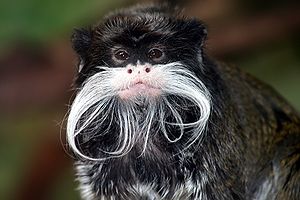Portal:Primates
The Primates Portal A primate is a member of the biological order Primates, the group that contains lemurs, the aye-aye, lorisids, galagos, tarsiers, monkeys, and apes, with the last category including great apes. With the exception of humans, who inhabit every continent on Earth, most primates live in tropical or subtropical regions of the Americas, Africa and Asia. Primates range in size from the 30-gram (1 oz) pygmy mouse lemur to the 200-kilogram (440 lb) mountain gorilla. According to fossil evidence, the primitive ancestors of primates may have existed in the late Cretaceous period around 65 mya (million years ago), and the oldest known primate is the Late Paleocene Plesiadapis, c. 55–58 mya. Molecular clock studies suggest that the primate branch may be even older, originating in the mid-Cretaceous period around 85 mya. Primates exhibit a wide range of characteristics. Some primates do not live primarily in trees, but all species possess adaptations for climbing trees. Locomotion techniques used include leaping from tree to tree, walking on two or four limbs, knuckle-walking, and swinging between branches of trees (known as brachiation). Primates are characterized by their large brains relative to other mammals. These features are most significant in monkeys and apes, and noticeably less so in lorises and lemurs. Many species are sexually dimorphic, which means males and females have different physical traits, including body mass, canine tooth size, and coloration.
Selected articleIndraloris is a fossil primate from the Miocene of India and Pakistan in the family Sivaladapidae. Two species are now recognized: I. himalayensis from Haritalyangar, India (about 9 million years old) and I. kamlialensis from the Potwar Plateau, Pakistan (15.2 million years old). Body mass estimates range from about 2 kg (4.4 lb) for the smaller I. kamlialensis to over 4 kg (8.8 lb) for the larger I. himalayensis. Indraloris is known from isolated teeth and fragmentary lower jaws. Indraloris may have been arboreal and at least partly frugivorous. When the first Indraloris fossils were discovered in the early 1930s, one was misidentified as a carnivoran and the other as a loris. The carnivoran identification was corrected in 1968, and in 1979 Indraloris and the related Sivaladapis were identified as late survivors of Adapiformes, an archaic primate group. Selected picture Emperor tamarins inhabit tropical rain forests, living deep in the forest and also in open tree-covered areas. This diurnal species walks or runs quadrupedally through the forest, spending the majority of its days in the trees with quick, safe movements and broad jumps among the limbs. CategoriesSelected species Least Concern (IUCN 3.1)|Least Concern The vervet monkey (Chlorocebus pygerythrus), or simply vervet, is an Old World monkey of the family Cercopithecidae native to Africa. The term "vervet" is also used to refer to all the members of the genus Chlorocebus. The five distinct subspecies can be found mostly throughout Southern Africa, as well as some of the eastern countries. Vervets were transported to the islands of Barbados, Saint Kitts, and Nevis in conjunction with the African slave trade. These mostly vegetarian monkeys have black faces and grey body hair color, ranging in length from about 19 in (50 cm) for males to about 16 in (40 cm) for females. In addition to very interesting behavioral research on natural populations, vervet monkeys serve as a nonhuman primate model for understanding genetic and social behaviors of humans. They have been noted for having human-like characteristics, such as hypertension, anxiety, and social and dependent alcohol use. The most significant studies done on vervet monkeys involve their communication and alarm calls, specifically in regard to kin and group recognition and particular predator sightings. Did you know?
Primate lists
WikiProjectsThings to do
Associated WikimediaDiscover Wikipedia using portals |
















